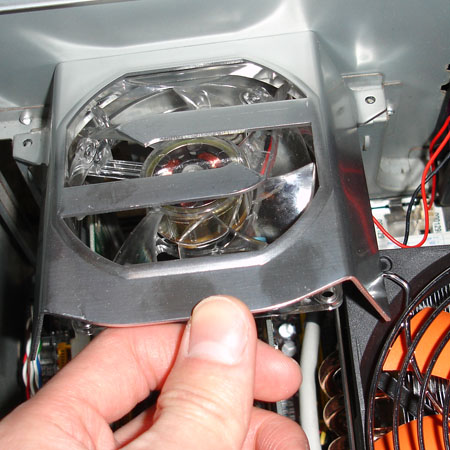Need additional cooling on your expansion cards? If so, check out our review on the CoolIT Systems PCI Cooling Booster. This little 80mm fan mounts above the PCI expansion slot to offer additional cooling to the area where cooling is usually not as readily available as other components. Check out out review and see how well this fan performs.
INTRODUCTION
Bjorn3D has looked at the CoolIT Systems’s Freezone and the Ram Fan in the past and was fairly satisfied with the CoolIT’s ability to bring good cooling products to the market, especially the Freezone. Today, we will be looking at yet another CoolIT’s product, the PCI Cooling Booster, a rather unique product which is designed to help cool the expansion cards.

SPECIFICATION
- Voltage: 12
- Power: 2Watt
- Speed: 3000rpm
- Airflow: 38.88 CFM
- Noise: 32.31 dBA
Features:
- Provides direct air flow to cool PCI components.
- Simple to Install
- Simple bolt-in to any standard 7 slot PCI bay
- Plugs into any available fan header
- Cools PCI Components
- Provides direct airflow to cool all PCI cards to increase stability and reliability
- Guaranteed to reduce temperatures on video cards
- Maximize overclocking potential
CLOSER LOOK

The PCI Cooling Booster comes in the same package as the Ram Fan which is in a sealed plastic box that requires a sharp knife to open it up. You can clearly see the fan on the front and read the features of the fan on the package.





INSTALLATION
TESTING SYSTEM
- Processor: AMD Athlon 64 X2 4200+ Manchester
- Memory: 2x G.Skill Extreme Series (F1-3200PHU2-2GBZX)
- Motherboard: DFI Lanparty nF4 SLI-DR (BIOS NF4LD406)
- Graphics Card: Gigabyte GeForce 7900 GT (GV-NX79T256DP-RH)
- Sound Card: Onboard
- Internal Hard drive: Maxtor DiamondMax Plus10 250GB Hard Drive (Maxtor 6B250S0), 250GB, 7,200 rpm, 16 MB Cache, SATA 150
- LAN: NVIDIA nForce 4 Gigabit ethernet, forceware 6.86
RESULT
|
|
Lowest temperature | Lowest Temperature | Highest Temperature | Highest Temperature |
| without the fan | with the fan | without the fan | with the fan | |
|
Motherboard |
38 | 42 | 46 | 48 |
|
CPU |
32 | 33 | 40 | 40 |
|
Core 1 |
32 | 31 | 46 | 47 |
|
Core 2 |
28 | 28 | 43 | 43 |
|
Northbridge |
39 | 41 | 43 | 44 |
|
GPU |
44 | 46 | 62 | 63 |
The result is somewhat disappointing as we can see that the PCI Cooling Booster does not really help to cool the components, rather it actually makes the components slightly hotter. I think it’s possible that the fan blows hot air away from certain areas into some of the sensors thus making the temperature hotter. We see the GPU is also not getting the promised cooling either but that could due to the fact that the Gigabyte graphic card (GV-NX79T256DP-RH) that I was using actually has a modified heatsink and fan which provides better cooling. The placement of the PCI Cooling Booster could also be the culprit as it does not really cover the center of the GPU’s fan. Many of today’s graphic cards are long and they have the fan actually closer to the middle and front of the card and have the hot air escape the graphic cards through the rear. The PCI Cooling Booster actually is closer to the rear of the card, so it may not be able to efficiently push the hot air away from the card to assist GPU’s cooling.
CONCLUSION
The PCI Cooling Booster is a good concept as it adds cooling to the area where additional cooling is usually not as readily available as other areas inside the system. However, it’s performance is not as good as I would have hoped. Furthermore, the installation, although simple, can be problematic for some people with tool-less case and/or cases with side panel fans. For a system that does not have proper ventilation, the PCI Cooling Booster may serve as a good addition and may provide some assistance in cooling. However, if you have the option of installing a 120 mm case fan or have other means of replacing the heat sink and the fan of the internal components, then that would be the better option as we see that they are far more effective than the PCI Cooling Booster.
Pros:
+ Nice concept
+ Quiet
+ Nice looking LED
+ Easy installation
Cons:
– Not for screwless cases and maybe even case with side panel fans
– May not enhance added cooling for a well ventilated case
– Short fan power cable
 Bjorn3D.com Bjorn3d.com – Satisfying Your Daily Tech Cravings Since 1996
Bjorn3D.com Bjorn3d.com – Satisfying Your Daily Tech Cravings Since 1996







